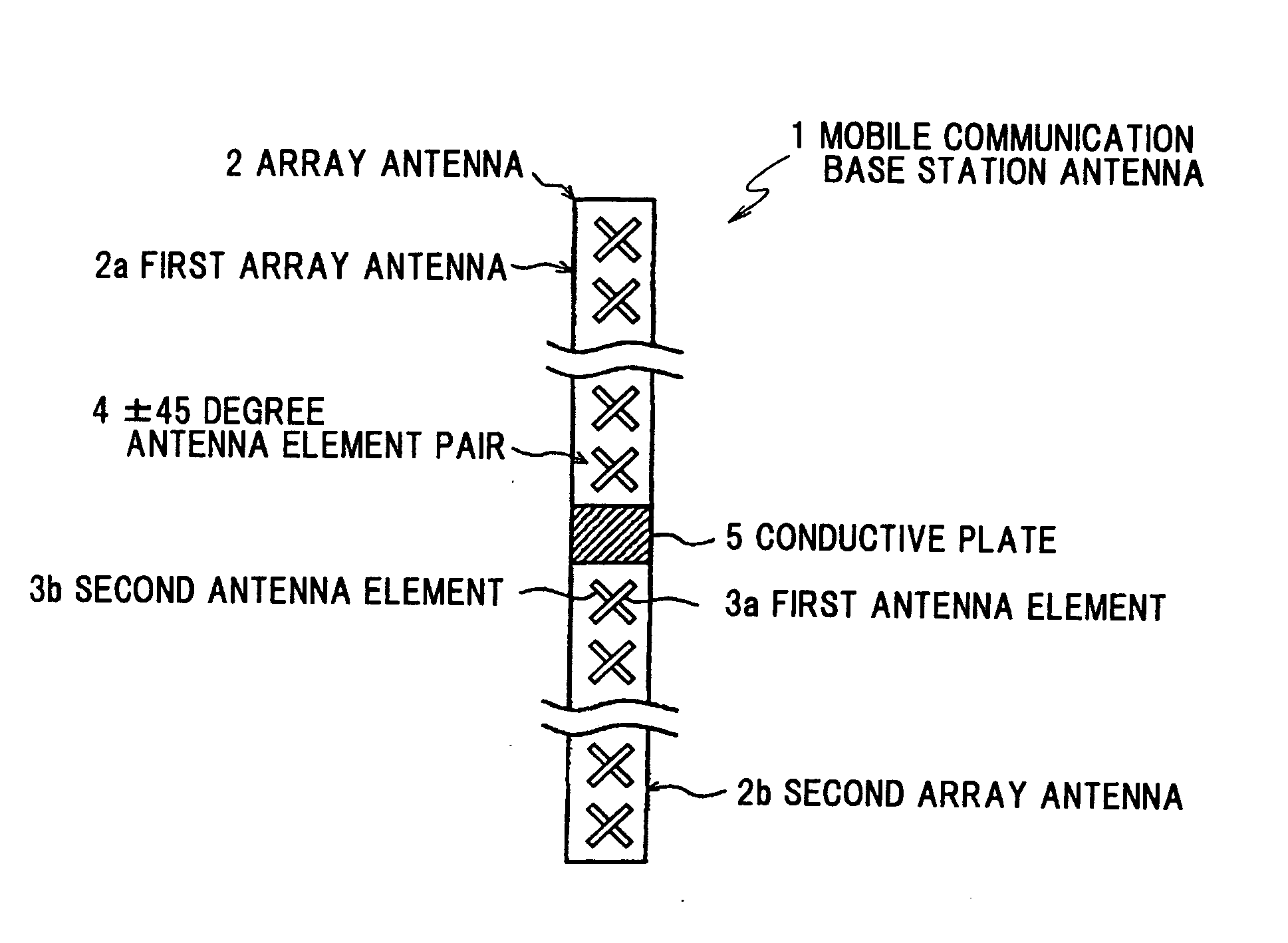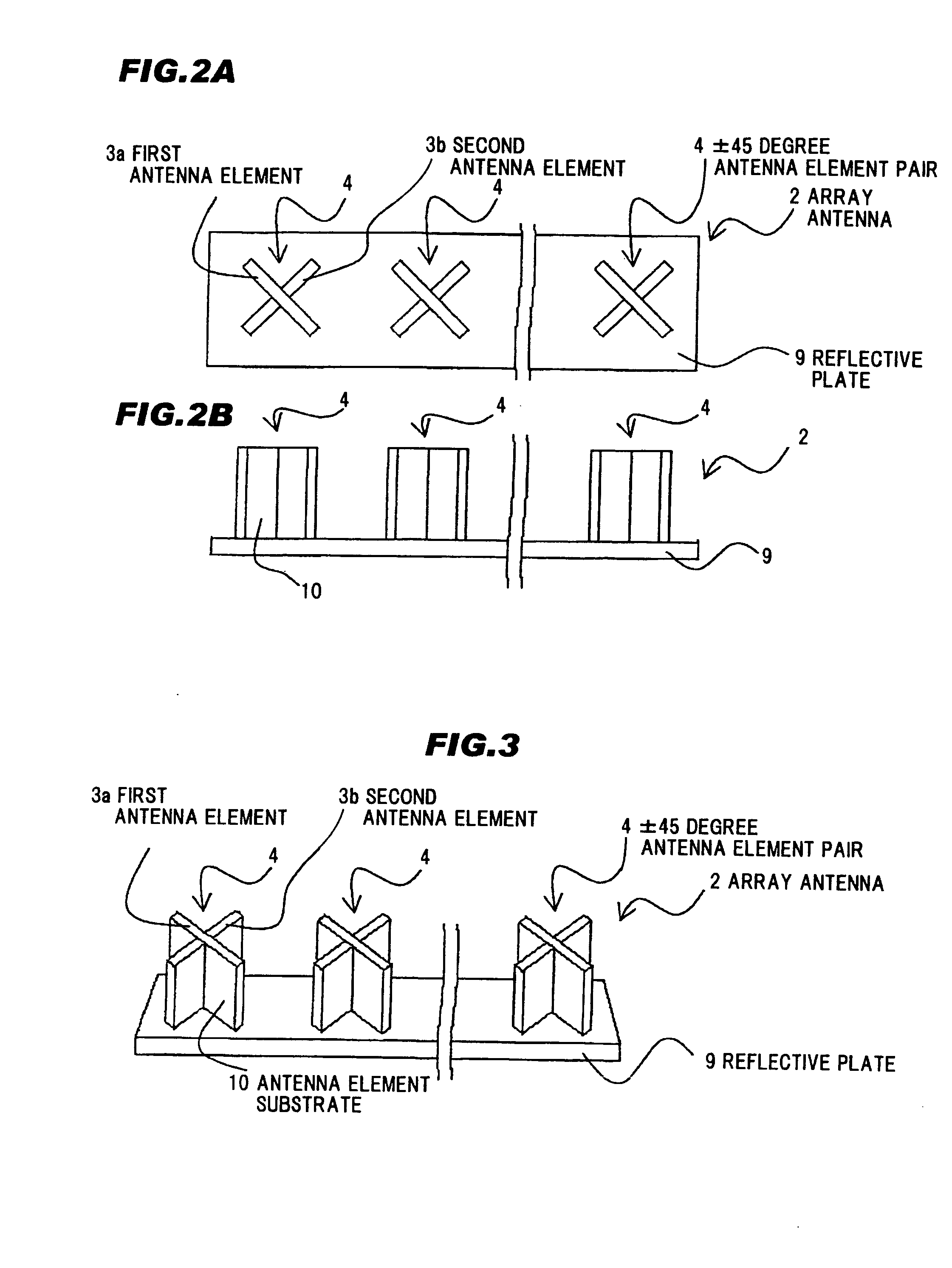Mobile Communication base station antenna
a mobile communication and antenna technology, applied in the direction of antennas, antenna details, antenna feed intermediates, etc., can solve the problems of short frequency range, increased installation occupied area of mobile communication base station antenna in total, and increased installation occupied area of mobile communication base station antenna
- Summary
- Abstract
- Description
- Claims
- Application Information
AI Technical Summary
Benefits of technology
Problems solved by technology
Method used
Image
Examples
first preferred embodiment
[0046]FIG. 1 is a schematic diagram of the mobile communication base station antenna in a first preferred embodiment according to the invention.
[0047]As shown in FIG. 1, a mobile communication base station antenna 1 comprises two or more array antennas 2 (two array antennas 2 in FIG. 1), and respective array antennas 2 are arranged in a vertical direction with a predetermined interval (distance). In this preferred embodiment, the mobile communication base station antenna 1, in which a first array antenna 2a and a second array antenna 2b are arranged in the vertical direction, will be explained.
[0048]The first and second array antennas 2a, 2b are connected with each other via a conductive plate 5. The conductive plate 5 is provided as a common ground potential (GND potential) for the first and second array antennas 2a, 2b. The first and second array antennas 2a, 2b are located to be separated from each other with a predetermined distance in the vertical direction.
[0049]Each of the fi...
second preferred embodiment
[0080]Next, a mobile communication base station antenna 61 in a second preferred embodiment will be explained below.
[0081]FIG. 8 is a schematic diagram of the mobile communication base station antenna 61 in the second preferred embodiment according to the present invention. In the second preferred embodiment, the array antenna 2 in which the ±45 degree antenna element pairs 4 are arranged in the array shape in the mobile communication base station antenna 1 shown in FIG. 1 is replaced with an array antenna 63 in which horizontal-vertical antenna element pairs 62 are arranged in array shape. In the horizontal-vertical antenna element pair 62, a first antenna element (vertical antenna element) 64a is located vertically and a second antenna element (horizontal antenna element) 64b is located horizontally.
[0082]In the mobile communication base station antenna 61, the ±45 degree antenna element pairs 4 are replaced with the horizontal-vertical antenna element pairs 62. Therefore, it is p...
third preferred embodiment
[0083]Next, a mobile communication base station antenna 71 in a third preferred embodiment will be explained below.
[0084]FIG. 9 is a schematic diagram of the mobile communication base station antenna 71 in the third preferred embodiment according to the present invention.
[0085]In the mobile communication base station antenna 71 as shown in FIG. 9, the array antenna 2 in which the ±45 degree antenna element pairs 4 are arranged in the array shape and the array antenna 63 in which the horizontal-vertical antenna element pairs 62 are arranged in the array shape are arranged in the vertical direction.
[0086]Since a polarization direction of the array antenna 2 is different from that of the array antenna 63, it is possible to reduce the antenna correlation coefficient between the array antenna 2 and the array antenna 63 by arranging the array antenna 2 and the array antenna 63 to be adjacent to each other, compared with the first preferred embodiment in which the array antennas 2 are adja...
PUM
 Login to View More
Login to View More Abstract
Description
Claims
Application Information
 Login to View More
Login to View More - R&D
- Intellectual Property
- Life Sciences
- Materials
- Tech Scout
- Unparalleled Data Quality
- Higher Quality Content
- 60% Fewer Hallucinations
Browse by: Latest US Patents, China's latest patents, Technical Efficacy Thesaurus, Application Domain, Technology Topic, Popular Technical Reports.
© 2025 PatSnap. All rights reserved.Legal|Privacy policy|Modern Slavery Act Transparency Statement|Sitemap|About US| Contact US: help@patsnap.com



